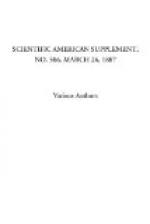In the arrangement described, a single lens is used for the condenser, not because it is better than a double one, as is general for such purposes, but because it is quite sufficient for the purpose. Of course, a large condenser is both expensive and cumbersome. There is, therefore, no advantage in using a combination if a single lens will answer.
In reproducing lantern pictures from half-plate negatives, the time required on my lantern plates is from two to four minutes, using 6 inch condenser. For whole plate negatives, from two to six minutes with a 9 inch condenser. In working in this way it is easy to be developing one picture while exposing another.
The condenser must be of such a size that it will cover the plate from corner to corner. The best part of an 81/2 x 61/2 negative will be covered by a 9 inch condenser, and a 61/2 x 43/4 by a 6 inch condenser.
With this arrangement it will be easy to reproduce from half or whole plate negatives or any intermediate sizes quite independently of daylight.
* * * * *
EXPERIMENTS IN TONING GELATINO-CHLORIDE PAPER.
From the Photographic News we take the following: The use of paper coated with a gelatino-citro-chloride emulsion in place of albumenized paper appears to be becoming daily more common. Successful toning has generally been the difficulty with such paper, the alkaline baths commonly in use with albumenized having proved unsuitable for toning this paper. On the whole, the bath that has given the best results is one containing, in addition to gold, a small quantity of hypo and a considerable quantity of sulphocyanide of ammonium. Such a bath tones very rapidly, and gives most pleasing colors. It appears, moreover, to be impossible to overtone the citro-chloro emulsion paper with it in the sense that it is possible to overtone prints on albumenized paper with the ordinary alkaline bath. That is to say, it is impossible to produce a slaty gray image. The result of prolonged toning is merely an image of an engraving black color. Of this, however, we shall say more hereafter. We wish first of all to refer to an elaborate series of experiments by Lionel Clark on the effects of various toning baths used with the gelatino-citro-chloride paper.
The results of these experiments we have before us at the time of writing, and we may at once say that, from the manner in which the experiments have been carried out and in which the results have been tabulated, Lionel Clark’s work forms a very useful contribution to our photographic knowledge, and a contribution that will become more and more useful, the longer the results of the experiments are kept. A number of small prints have been prepared. Of these several—in most cases, three—have been toned by a certain bath, and each print has been torn in two. One-half has been treated with bichloride of mercury, so as to bleach such portion of the image as is of silver, and finally the prints—the two halves of each being brought close together—have been mounted in groups, each group containing all the prints toned by a certain formula, with full information tabulated.




